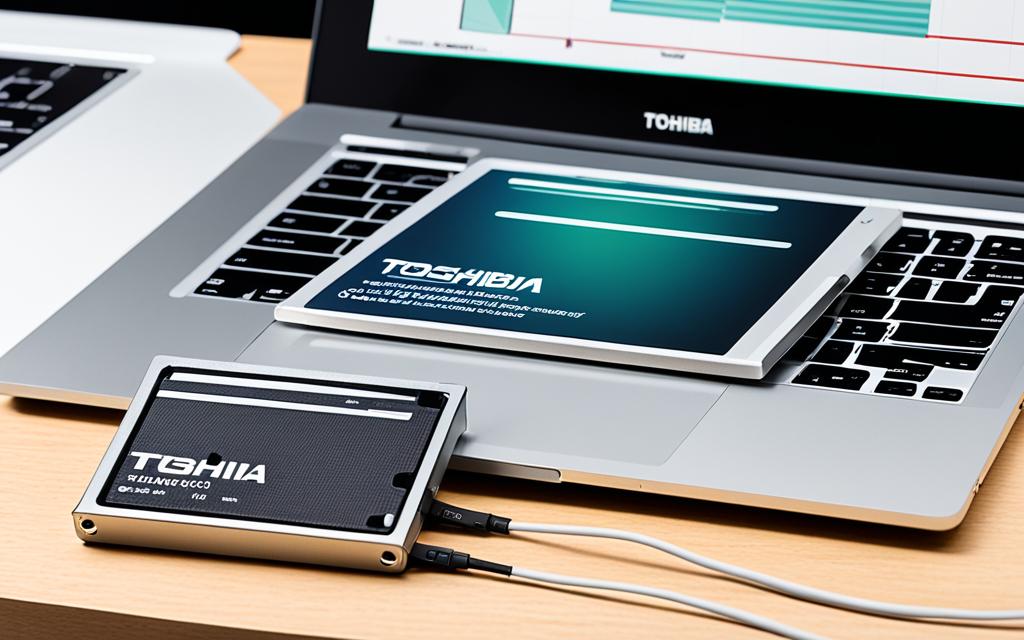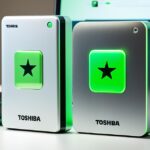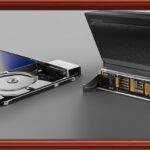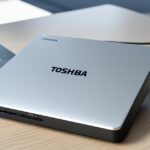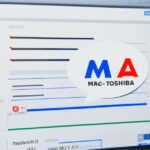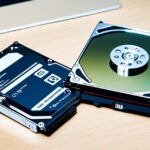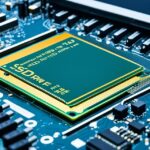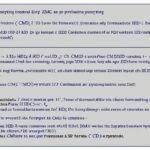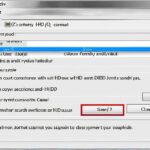Table of Contents
In our world today, it’s vital to make sure your Toshiba external hard drive works well with Macs. Most of the time, these drives are set up for Windows out of the box. They use a system called NTFS which doesn’t mesh well with macOS1. To make the most out of your drive, you’ll need to format it for Mac. This step lets you use it smoothly across different devices.
Getting to grips with how to do this is important, especially if you’re moving from using a PC to a Mac. Once you know what’s needed, you can get your drive ready for anything2.
Key Takeaways
- Toshiba external hard drives are often pre-formatted for Windows and require reformatting for Mac compatibility.
- Choosing the right file system is crucial for effective use on Mac; ExFAT is generally recommended for cross-platform compatibility.
- Disk Utility is the primary tool for formatting Toshiba drives on Mac systems.
- Regular backups are essential to prevent data loss before formatting.
- Utilising data recovery software may be necessary if data loss occurs during the formatting process.
Understanding the Compatibility Issues
It’s vital to grasp why compatibility issues occur with Toshiba hard drives and Macs. Many problems stem from different file systems used by each. Macs usually use HFS+ or APFS, unlike Toshiba’s NTFS. This difference can make it hard to use the drives well on a Mac.
The Difference Between File Systems
File system variances greatly affect how things work together. Toshiba drives are often NTFS, which Macs struggle with. They can’t write to these drives without help. To avoid losing important info, you might need to switch the drive’s format to something Mac-friendly. But first, make sure to back up your data. Tools like Wondershare Recoverit can help3
Common Problems When Connecting to Mac
Connecting Toshiba drives to Macs can lead to several issues. You might face bad USB connections or files getting corrupt. Sometimes, the drives don’t show up where they should. Issues could be due to poor USB cables, outdated software, or formats Mac doesn’t recognise4. To fix this, check your USB connections and settings in Finder to show external disks.
How to Make a Toshiba External Hard Drive for Mac
To use your Toshiba external hard drive with a Mac, some important steps are needed. First, make sure the drive is well connected to your Mac. Know that formatting the drive deletes all data, so back up any important files first.
Preparing Your External Hard Drive
Make sure your Toshiba external hard drive is plugged in correctly before starting. Checking the connection helps avoid problems later. It’s also wise to go through the drive’s content since formatting will erase everything. Always back up your data first.
Formatting Steps Using Disk Utility
After preparing your Toshiba drive, the next step is formatting it. Open Disk Utility from the Applications folder. Then, choose your Toshiba drive from the sidebar and hit the ‘Erase’ button. This leads to an option to pick the file system.
For Mac OS Sierra users, Mac OS Extended (Journaled) is recommended. After setting this up, your drive will be ready for formatting. This process is quick and prepares your drive for Mac, usually taking a few minutes.
Looking for more tips on setting up your external hard drive? Check this detailed guide at How to Install a Hard Drive in a PC. It will help improve your Toshiba hard drive’s setup, reducing compatibility issues and ensuring it works well5.
Step-by-Step Formatting Guide
Setting up a Toshiba external hard drive on a Mac might seem hard. But, following a clear formatting guide for Mac can make it easy and make sure it works well. You need to open Disk Utility to handle the external drive right.
Accessing Disk Utility on Mac
To start, find and open Disk Utility through Applications > Utilities. This tool helps you manage disks and drives, letting you format and erase them. It’s key for doing what you need with your Toshiba drive.
Erasing and Reformatting the Drive
Within Disk Utility, pick the Toshiba drive from the sidebar. Then, press the ‘Erase’ button. This step begins erasing Toshiba drive. You’ll need to name it and choose a format. Pick a format that fits how you’ll use the drive.
Selecting the Appropriate File System
Finding the right file system is key. You could pick ‘Mac OS Extended (Journaled)’ or ‘exFAT’. Which one you need depends on your macOS version. Older versions before macOS 10.12 work with HFS+. macOS 10.13 and newer use APFS, good for SSDs6. Picking the wrong format could cause problems later. For big files, exFAT is great as it works well and doesn’t have FAT327‘s limits.
Investigating Connection Issues
When you’re having trouble with your Toshiba drive, check the USB ports and cables first. Often, the issue is with faulty cables or broken ports. These can stop your external hard drive from connecting with your Mac. To figure out the problem, try different USB ports. If that doesn’t work, use another cable. This can show you if the trouble is with the connections, not the drive itself.
Checking USB Ports and Cables
Still having issues? Then, it’s wise to try the Toshiba drive on a different Mac. This step helps in troubleshooting. By using another system, you can see if there’s a problem with your Mac or the drive. Sometimes, drives disconnect randomly on various Mac models, including the new Mac mini. Testing on another device helps you avoid issues specific to your Mac89.
Testing the Toshiba Drive on Another Mac
If your Toshiba drive works fine on a second Mac, check your original Mac’s settings. Disconnects can happen due to OS issues or incorrect shutdowns. These might harm connected drives9. If problems continue even after checking connections, you might need to look deeper. Sometimes, you need expert advice. If you can’t solve the issue on your that, asking for professional help is a good idea. For a detailed check on the Toshiba hard drive, click here.
FAQ
How can I determine if my Toshiba external hard drive is compatible with my Mac?
Most Toshiba hard drives are formatted for Windows, using NTFS. This means they might not work with macOS. To check, connect the drive to your Mac. See if it shows up on the desktop or use Disk Utility to check its format.
What should I do if my Toshiba drive doesn’t show up on my Mac?
If your Toshiba drive is missing, it could be due to corrupt files or settings. First, make sure it’s properly connected. Check your USB ports as well. Then, see if Disk Utility recognizes it. If it still doesn’t work, you might need to reformat it for your Mac.
What steps are involved in preparing my Toshiba external hard drive for formatting?
Before formatting your Toshiba drive, connect it to your Mac. Back up any key files. Remember, formatting wipes all data.
How do I format my Toshiba external drive using Disk Utility?
To format your Toshiba drive, start Disk Utility from Applications > Utilities. Pick your drive and click ‘Erase’. Then, select a Mac-compatible file system. Choose from ‘Mac OS Extended (Journaled)’ or ‘APFS’. It’s a quick process that makes your drive work with Mac.
What are the differences between file systems like NTFS, HFS+, and APFS?
Windows uses NTFS, while Mac uses HFS+ and APFS. NTFS is read-only on Mac unless you use special software. HFS+ suits older Macs. APFS is best for newer macOS versions, starting from High Sierra, because it improves performance.
How can I troubleshoot connection problems with my Toshiba drive?
For connection problems, first check your USB ports. Make sure your cables are okay too. Try connecting to different USB ports. If that fails, attempt using a new cable. You can also try the drive on another Mac to find the issue.
What should I do if my Toshiba external hard drive works on another Mac but not on mine?
If your Toshiba drive works on another Mac, your Mac might have a setting issue. Make sure your macOS is current. Check the drive in Disk Utility. Also, review your system preferences to ensure they’re not causing the problem.
Source Links
- https://gadgetmates.com/toshiba-canvio-mac-setup – Toshiba Canvio Mac Setup Instructions – GadgetMates
- https://news.macgasm.net/tips/format-toshiba-external-hard-drive-for-mac/ – How to Format Toshiba External Hard Drive for Mac | Guide
- https://recoverit.wondershare.com/harddrive-tips/toshiba-external-hard-drive-not-working-on-mac.html – Toshiba External Hard Drive Not Working on Mac [Fixed]
- https://mackeeper.com/blog/toshiba-external-hard-drive-not-working-on-mac/ – Toshiba External Hard Drive Not Working On Mac
- https://www.stellarinfo.com/article/toshiba-external-hard-drive-not-showing-up-on-mac.php – 7 Solutions to Fix Toshiba External Hard Drive not Showing Up on Mac
- https://www.linkedin.com/pulse/format-toshiba-external-hard-drive-mac-macgasm-j0elf – How to Format a Toshiba External Hard Drive for Mac: Complete Tutorial
- https://asapdatarecovery.com/format-toshiba-external-hard-drive/ – How to Format Toshiba External Hard Drive: A Step-by-Step Guide
- https://talk.tidbits.com/t/catalina-users-are-you-seeing-external-hard-drive-disconnects/12135?page=2 – Catalina users, are you seeing external hard drive disconnects?
- https://setapp.com/how-to/fix-disk-not-readable-issue – Fix “the disk you inserted was not readable by this computer” issue

